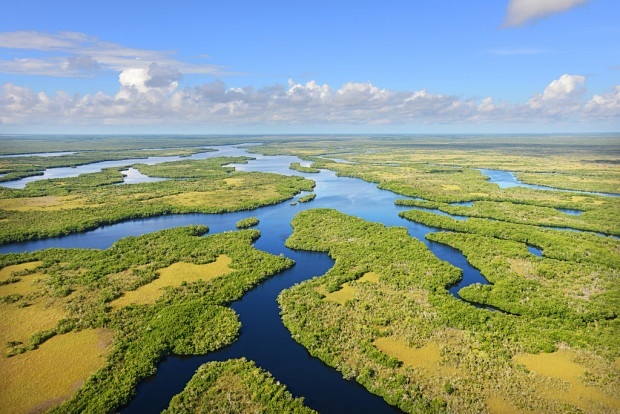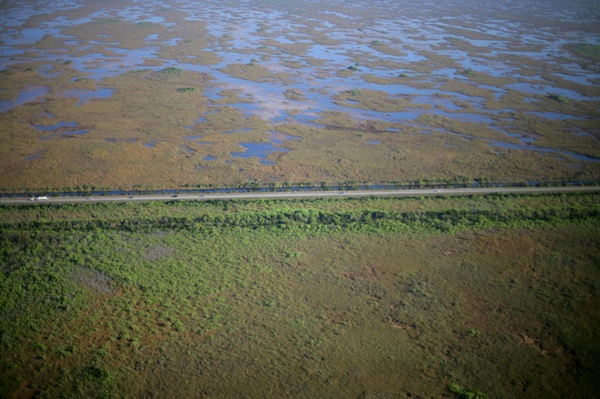We have much more to do and your continued support is needed now more than ever.
Restoring the Everglades, Restoring the Gulf
The Everglades and the Gulf of Mexico have much in common: They are both American treasures that have suffered from a half-century’s worth of degradation, resulting in ecosystems that are disappearing at an alarming rate, fisheries that are a mere vestige of what they once were, and communities that are increasingly vulnerable to rising sea levels, more frequent and powerful storms, and flooding.

The RESTORE Act: The Key to Restoring the Everglades
While a comprehensive restoration plan for the Everglades exists on paper, there have been major roadblocks to obtaining the necessary authorizations and funding to implement the plan.
But a recently-passed law called the RESTORE Act will dedicate 80% of the Clean Water Act fines resulting from the oil spill towards restoration. This law—particularly its comprehensive ecosystem restoration plan that will dictate much of how its money is spent—gives priority to large-scale ecosystem projects that will restore the resiliency of the Gulf of Mexico. As the Everglades are incredibly important nursery grounds for many of the Gulf’s fish species, projects that would restore the health of the Everglades would benefit the health of the Gulf as a whole, and therefore could likely quality for funding from the RESTORE Act.
Elevating the Tamiami Trial Highway
Tamiami Trail is a highway that was the first direct route across the Everglades, connecting Tampa and Miami. Since its construction in the 1920s, Tamiami Trail has acted as a dam, impeding the historic and natural north-south flow of water through Everglades National Park. As a result, this part of the Everglades and southern Gulf Coast is starved of fresh water, leading to deterioration of important bird and wildlife habitat in Florida Bay and Ten Thousand Islands. These estuaries are essential to the survival of fish and wading birds in what was once among the nation’s most ecologically productive areas.
One mile of roadway has already been elevated, and the Next Steps Project would elevate another 5.5 mile portion, reestablishing seasonal flows and restoring water quality and vital habitat for fish and wildlife.

West Basin Storage Reservoir Project
Under current practice, in times of drought, water that would normally flow into the Caloosahatchee estuary—another critical nursery ground for fish in the Gulf—is held back to meet water supply needs. During the wet times, when Lake Okeechobee rises to a level that threatens the integrity of the Herbert Hoover Dike, large volumes of polluted, nutrient-laden water is discharged to the Caloosahatchee estuary. These releases trigger algal blooms, seagrass loss, and disrupt Caloosahatchee’s salinity balance.
The Comprehensive Everglades Restoration Plan calls for the construction of an above-ground reservoir dubbed C-43 next to the Caloosahatchee River in Hendry County. This proposed reservoir would capture stormwater runoff and water released from Lake Okeechobee during the wet season and release this water during drier times in order to mimic more natural flows and to restore salinity balances in the estuary.
These more natural, seasonal fluctuations would protect habitat for nearly 40 percent of Florida’s rare, threatened, and endangered species. The project has also tremendous economic value for the people who depend on the ecologial health of the unique marine, estaurine, and freshwater wetlands of the region for their livehihood and property values.

A Win for the Environment & Economy
Restoring the ecological integrity of the Everglades would improve the resiliency and health of the Gulf of Mexico and these two projects should compete well for priority funding from the Oil Spill Restoration Impact Allocation in the RESTORE Act.
Funding from the RESTORE Act could allow us to leave our children and grandchildren a lasting legacy of healthy fish, wildlife, seafood and resilient coastal communities—but only if we make wise investments with this money today.
![]() Please take a moment to urge the Secretary of Commerce to ensure that the RESTORE Act funds are used on projects—like these two Everglades projects—that will improve the health of the Gulf and benefit multiple species of wildlife affected by the Gulf oil disaster.
Please take a moment to urge the Secretary of Commerce to ensure that the RESTORE Act funds are used on projects—like these two Everglades projects—that will improve the health of the Gulf and benefit multiple species of wildlife affected by the Gulf oil disaster.






















